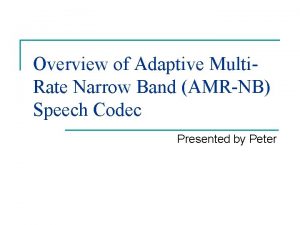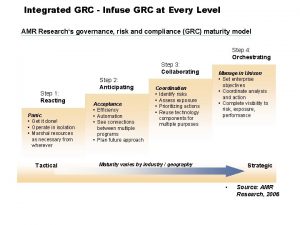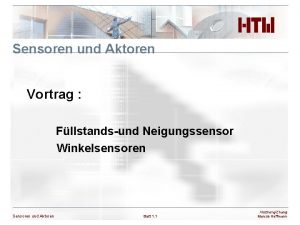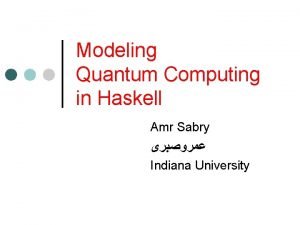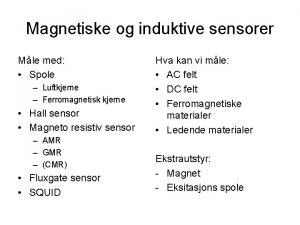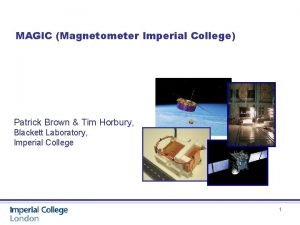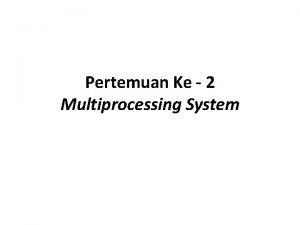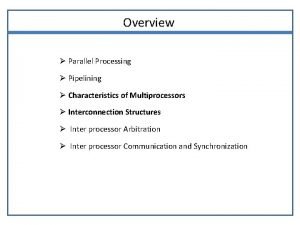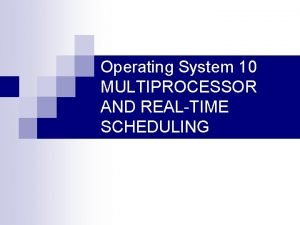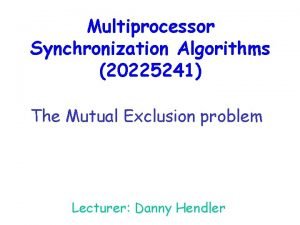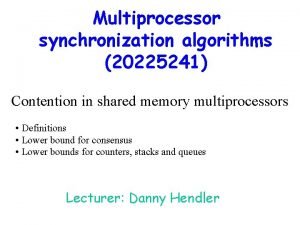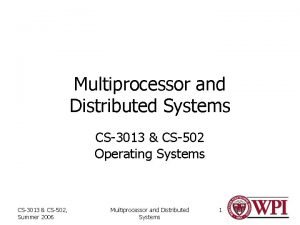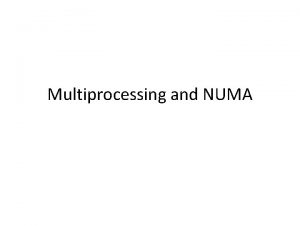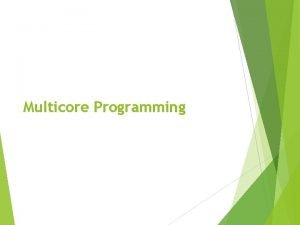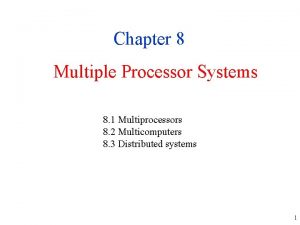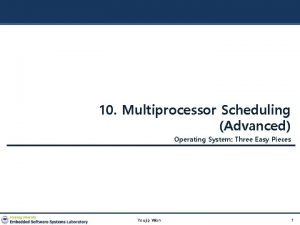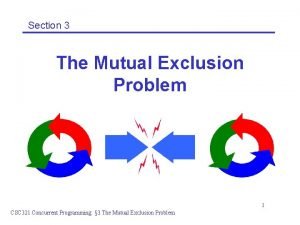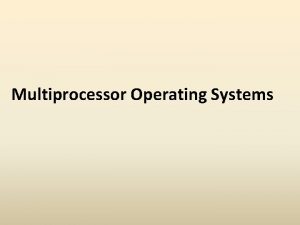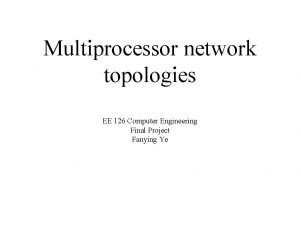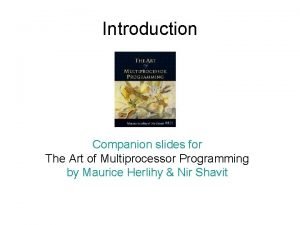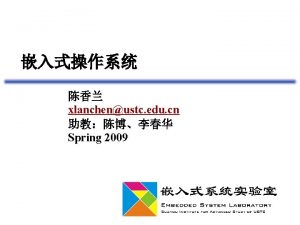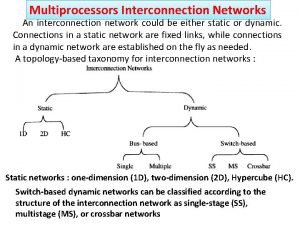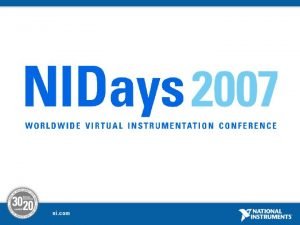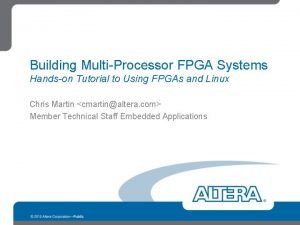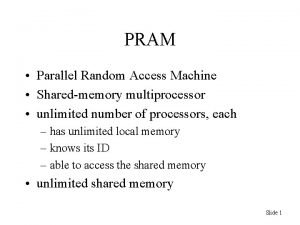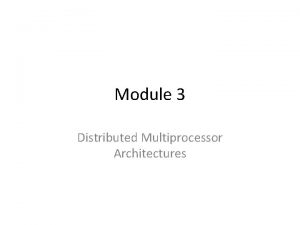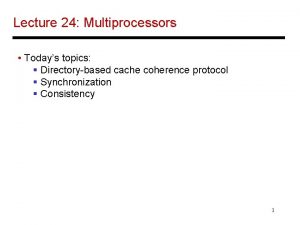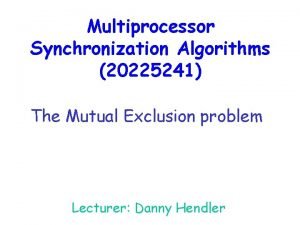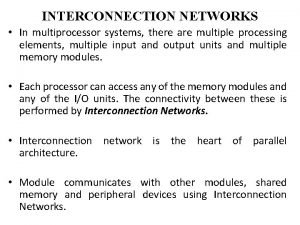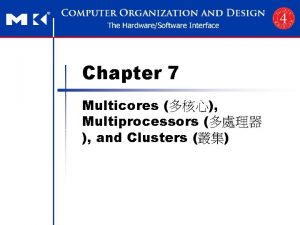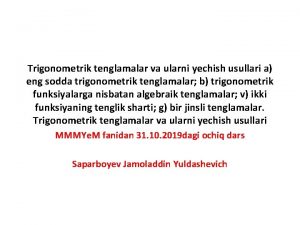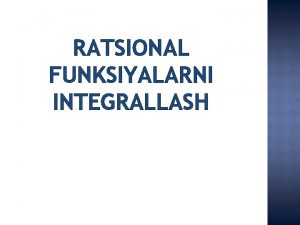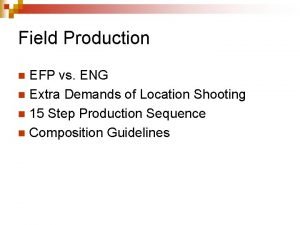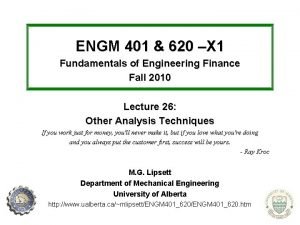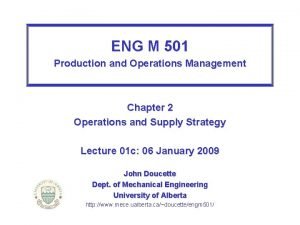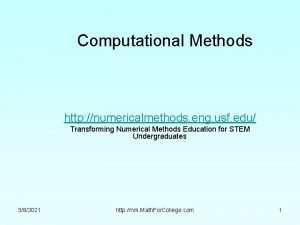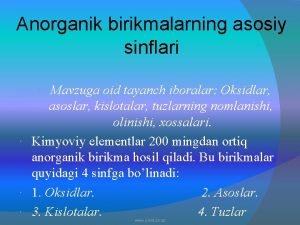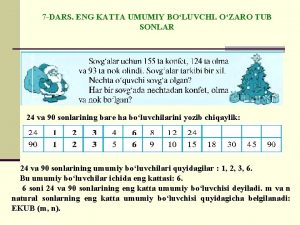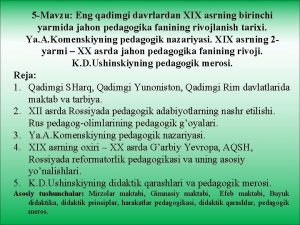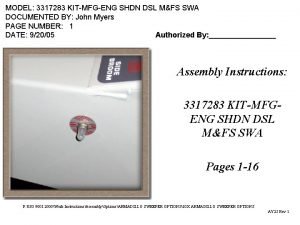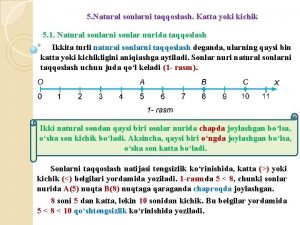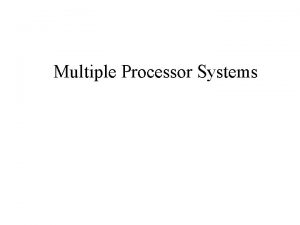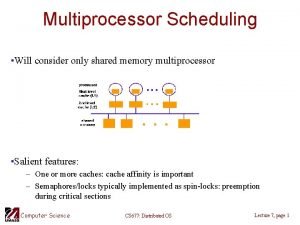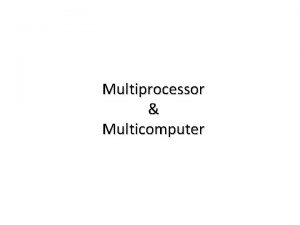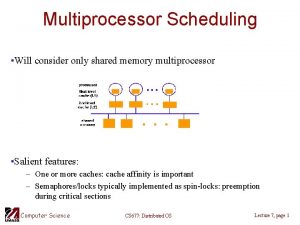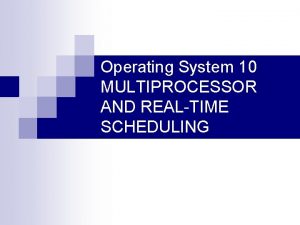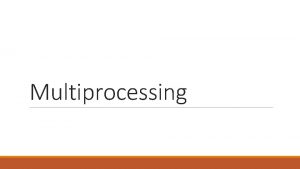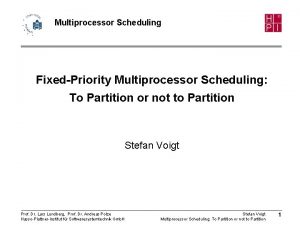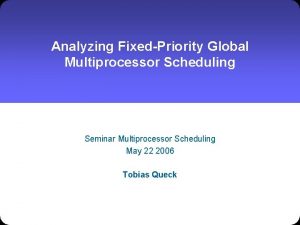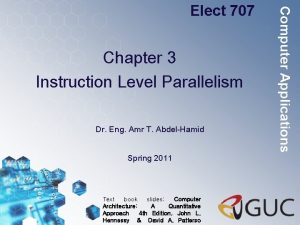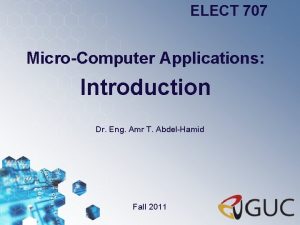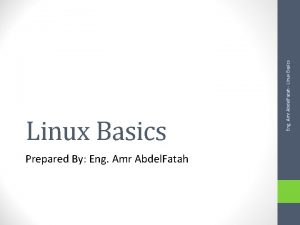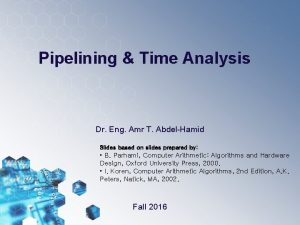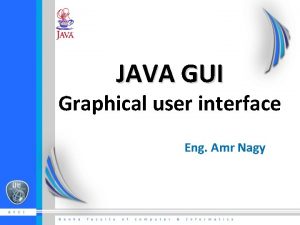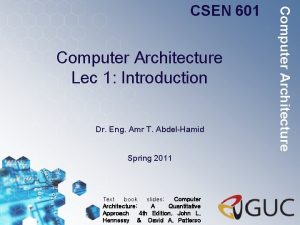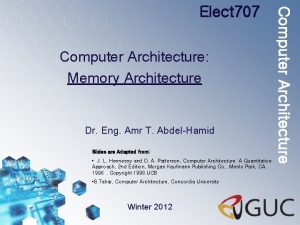Lecture 8 Chapter 4 Multiprocessor Dr Eng Amr




































































- Slides: 68

Lecture 8: Chapter 4: Multiprocessor Dr. Eng. Amr T. Abdel-Hamid Spring 2011 Text book slides: Computer Architecture: A Quantitative Approach 4 th Edition, John L. Hennessy & David A. Patterson with modifications. Computer Architecture CSEN 601

Uniprocessor Performance (SPECint) Computer Architecture 3 X From Hennessy and Patterson, Computer Architecture: A Quantitative Approach, 4 th edition, 2006 Dr. Amr Talaat • VAX : 25%/year 1978 to 1986 • RISC + x 86: 52%/year 1986 to 2002 • RISC + x 86: ? ? %/year 2002 to present CSEN Lecture 2

Flynn’s Taxonomy M. J. Flynn, "Very High-Speed Computers", Proc. of the IEEE, V 54, 1900 -1909, Dec. 1966. Computer Architecture Ø Flynn classified by data and control streams in 1966 Single Instruction Single Data (SISD) (Uniprocessor) Single Instruction Multiple Data (SIMD) (single PC: Vector, CM-2) Multiple Instruction Single Data (MISD) (ILP, Pipelining) Multiple Instruction Multiple Data (MIMD) (Clusters, SMP servers) Dr. Amr Talaat Ø SIMD Data Level Parallelism Ø MIMD Thread Level Parallelism Ø MIMD popular because Ø Flexible: N pgms and 1 multithreaded pgm Ø Cost-effective: same MPU in desktop & MIMD CSEN Lecture 2

Back to Basics Computer Architecture Ø “A parallel computer is a collection of processing elements that cooperate and communicate to solve large problems fast. ” Ø Parallel Architecture = Computer Architecture + Communication Architecture Ø 2 classes of multiprocessors WRT memory: 1. Centralized Memory Multiprocessor • < few dozen processor chips • Small enough to share single, centralized memory Dr. Amr Talaat 2. Physically Distributed-Memory multiprocessor • Larger number chips and cores than 1. • BW demands Memory distributed among processors CSEN Lecture 2

Centralized vs. Distributed Memory Computer Architecture Scale P 1 Pn $ $ Pn P 1 Mem $ Inter connection network Mem Dr. Amr Talaat Centralized Memory CSEN Lecture 2 Distributed Memory

Centralized Memory Multiprocessor Computer Architecture • Also called symmetric multiprocessors (SMPs) because single main memory has a symmetric relationship to all processors • Large caches single memory can satisfy memory demands of small number of processors • Can scale to a few dozen processors Dr. Amr Talaat • Although scaling beyond that is technically conceivable, it becomes less attractive as the number of processors sharing centralized memory increases CSEN Lecture 2

Distributed Memory Multiprocessor Computer Architecture Dr. Amr Talaat • Pro: Cost-effective way to scale memory bandwidth • If most accesses are to local memory • Pro: Reduces latency of local memory accesses • Con: Communicating data between processors more complex • Con: Must change software to take advantage of increased memory BW CSEN Lecture 2

2 Models for Communication and Memory Architecture Computer Architecture 1. Communication occurs by explicitly passing messages among the processors: message-passing multiprocessors 2. Communication occurs through a shared address space (via loads and stores): Ø shared memory multiprocessors either Dr. Amr Talaat • UMA (Uniform Memory Access time) for shared address, centralized memory MP • NUMA (Non Uniform Memory Access time multiprocessor) for shared address, distributed memory MP CSEN Lecture 2

Challenges of Parallel Processing Computer Architecture Dr. Amr Talaat Ø First challenge is % of program inherently sequential Ø Suppose 80 X speedup from 100 processors. What fraction of original program can be sequential? a. 10% b. 5% c. 1% d. <1% CSEN Lecture 2

Challenges of Parallel Processing Computer Architecture Dr. Amr Talaat Ø Second challenge is long latency to remote memory Ø Suppose 32 CPU MP, 2 GHz, 400 clock cycles remote memory access. Ø all local accesses hit memory hierarchy and base CPI is 0. 5. Ø What is performance impact if 0. 2% instructions involve remote access? a. 1. 5 X b. 2. 0 X c. 2. 5 X CSEN Lecture 2

Challenges of Parallel Processing Computer Architecture 1. Application parallelism primarily via new algorithms that have better parallel performance 2. Long remote latency impact both by architect and by the programmer Ø For example, reduce frequency of remote accesses either by Ø Caching shared data (HW) Ø Restructuring the data layout to make more accesses local (SW) Dr. Amr Talaat CSEN Lecture 2

Symmetric Shared-Memory Architectures Computer Architecture Ø Caches both Ø Private data are used by a single processor Ø Shared data are used by multiple processors Ø Caching shared data reduces latency to shared data, memory bandwidth for shared data, and interconnect bandwidth cache coherence problem Dr. Amr Talaat P 1 Pn $ $ Inter connection network Mem CSEN Lecture 2 Mem

Example Cache Coherence Problem P 2 Computer Architecture P 1 u=? $ P 3 3 u=? 4 $ 5 $ u : 5 u = 7 u : 5 I/O devices 1 u : 5 2 Memory Dr. Amr Talaat Ø Processors see different values for u after event 3 Ø With write back caches, value written back to memory depends on happenstance of which cache flushes or writes back value when Ø Processes accessing main memory may see very stale value Ø Unacceptable for programming, and its frequent! CSEN Lecture 2

Basic Schemes for Enforcing Coherence Computer Architecture Ø Program on multiple processors will normally have copies of the same data in several caches Ø Rather than trying to avoid sharing in SW, SMPs use a HW protocol to maintain coherent caches Ø Migration and Replication key to performance of shared data Ø Migration - data can be moved to a local cache and used there in a transparent fashion Ø Reduces both latency to access shared data that is allocated remotely and bandwidth demand on the shared memory Dr. Amr Talaat Ø Replication – for shared data being simultaneously read, since caches make a copy of data in local cache Ø Reduces both latency of access and contention for read shared data CSEN Lecture 2

Intuitive Memory Model Computer Architecture P L 1 100: 67 L 2 100: 35 Memory Disk 100: 34 • Reading an address should return the last value written to that address – Easy in uniprocessors, Dr. Amr Talaat Ø Too vague and simplistic; 2 issues 1. Coherence defines values returned by a read 2. Consistency determines when a written value will be returned by a read Ø Coherence defines behavior to same location, Ø Consistency defines behavior to other locations CSEN Lecture 2

Defining Coherent Memory System Computer Architecture Dr. Amr Talaat 1. Preserve Program Order: A read by processor P to location X that follows a write by P to X, with no writes of X by another processor occurring between the write and the read by P, always returns the value written by P 2. Coherent view of memory: Read by a processor to location X that follows a write by another processor to X returns the written value if the read and write are sufficiently separated in time and no other writes to X occur between the two accesses 3. Write serialization: 2 writes to same location by any 2 processors are seen in the same order by all processors Ø If not, a processor could keep value 1 since saw as last write Ø For example, if the values 1 and then 2 are written to a location, processors can never read the value of the location as 2 and then later read it as 1 CSEN Lecture 2

Write Consistency Computer Architecture Dr. Amr Talaat Ø For now assume 1. A write does not complete (and allow the next write to occur) until all processors have seen the effect of that write 2. The processor does not change the order of any write with respect to any other memory access if a processor writes location A followed by location B, any processor that sees the new value of B must also see the new value of A Ø These restrictions allow the processor to reorder reads, but forces the processor to finish writes in program order CSEN Lecture 2

2 Classes of Cache Coherence Protocols Computer Architecture 1. Directory based — Sharing status of a block of physical memory is kept in just one location, the directory 2. Snooping — Every cache with a copy of data also has a copy of sharing status of block, but no centralized state is kept • All caches are accessible via some broadcast medium (a bus or switch) • All cache controllers monitor or snoop on the medium to determine whether or not they have a copy of a block that is requested on a bus or switch access Dr. Amr Talaat CSEN Lecture 2

Snoopy Cache-Coherence Protocols Computer Architecture State Address Data Ø Cache Controller “snoops” all transactions on the shared medium (bus or switch) Ø relevant transaction if for a block it contains Ø take action to ensure coherence Dr. Amr Talaat Øinvalidate, update, (or supply value) Ø depends on state of the block and the protocol Ø Either get exclusive access before write via write invalidate or update all copies on write CSEN Lecture 2

Example: Write-thru Invalidate Computer Architecture P 2 P 1 u=? $ P 3 3 u=? 4 $ 5 $ u : 5 u = 7 u : 5 I/O devices 1 u : 5 2 u=7 Memory Dr. Amr Talaat Ø Must invalidate before step 3 Ø Write update uses more broadcast medium BW all recent MPUs use write invalidate CSEN Lecture 2

Architectural Building Blocks Computer Architecture Ø Cache block state transition diagram Ø FSM specifying how disposition of block changes Øinvalid, dirty Ø Broadcast Medium Transactions (e. g. , bus) Ø Fundamental system design abstraction Ø Logically single set of wires connect several devices Ø Protocol: arbitration, command/addr, data Every device observes every transaction Ø Broadcast medium enforces serialization of read or write accesses Write serialization Dr. Amr Talaat Ø 1 st processor to get medium invalidates others copies Ø cannot complete write until it obtains bus Ø All coherence schemes require serializing accesses to same cache block Ø Also need to find up-to-date copy of cache block CSEN Lecture 2

Locate up-to-date copy of data Ø Write-through: get up-to-date copy from memory Computer Architecture Ø Write through simpler if enough memory BW Ø Write-back harder Ø Most recent copy can be in a cache Ø Can use same snooping mechanism 1. Snoop every address placed on the bus 2. If a processor has dirty copy of requested cache block, it provides it in response to a read request and aborts the memory access Dr. Amr Talaat Ø Complexity from retrieving cache block from a processor cache, which can take longer than retrieving it from memory Ø Write-back needs lower memory bandwidth Support larger numbers of faster processors Most multiprocessors use write-back CSEN Lecture 2

Cache Resources for WB Snooping Computer Architecture Ø Ø Normal cache tags can be used for snooping Valid bit per block makes invalidation easy Read misses easy since rely on snooping Writes Need to know if know whether any other copies of the block are cached Ø No other copies No need to place write on bus for WB Ø Other copies Need to place invalidate on bus Dr. Amr Talaat CSEN Lecture 2

Cache Resources for WB Snooping Computer Architecture Ø To track whether a cache block is shared, add extra state bit associated with each cache block, like valid bit and dirty bit Ø Write to Shared block Need to place invalidate on bus and mark cache block as private (if an option) Ø No further invalidations will be sent for that block Ø This processor called owner of cache block Ø Owner then changes state from shared to unshared (or exclusive) Dr. Amr Talaat CSEN Lecture 2

Defining Coherent Memory System Computer Architecture Dr. Amr Talaat 1. Preserve Program Order: A read by processor P to location X that follows a write by P to X, with no writes of X by another processor occurring between the write and the read by P, always returns the value written by P 2. Coherent view of memory: Read by a processor to location X that follows a write by another processor to X returns the written value if the read and write are sufficiently separated in time and no other writes to X occur between the two accesses 3. Write serialization: 2 writes to same location by any 2 processors are seen in the same order by all processors Ø If not, a processor could keep value 1 since saw as last write Ø For example, if the values 1 and then 2 are written to a location, processors can never read the value of the location as 2 and then later read it as 1 CSEN Lecture 2

2 Classes of Cache Coherence Protocols Computer Architecture 1. Directory based — Sharing status of a block of physical memory is kept in just one location, the directory 2. Snooping — Every cache with a copy of data also has a copy of sharing status of block, but no centralized state is kept • All caches are accessible via some broadcast medium (a bus or switch) • All cache controllers monitor or snoop on the medium to determine whether or not they have a copy of a block that is requested on a bus or switch access Dr. Amr Talaat CSEN Lecture 2

Snoopy Cache-Coherence Protocols Computer Architecture State Address Data Ø Cache Controller “snoops” all transactions on the shared medium (bus or switch) Ø relevant transaction if for a block it contains Ø take action to ensure coherence Dr. Amr Talaat Øinvalidate, update, (or supply value) Ø depends on state of the block and the protocol Ø Either get exclusive access before write via write invalidate or update all copies on write CSEN Lecture 2

Example: Write-thru Invalidate Computer Architecture P 2 P 1 u=? $ P 3 3 u=? 4 $ 5 $ u : 5 u = 7 u : 5 I/O devices 1 u : 5 2 u=7 Memory Dr. Amr Talaat Ø Must invalidate before step 3 Ø Write update uses more broadcast medium BW all recent MPUs use write invalidate CSEN Lecture 2

Architectural Building Blocks Computer Architecture Ø Cache block state transition diagram Ø FSM specifying how disposition of block changes Øinvalid, dirty Ø Broadcast Medium Transactions (e. g. , bus) Ø Fundamental system design abstraction Ø Logically single set of wires connect several devices Ø Protocol: arbitration, command/addr, data Every device observes every transaction Ø Broadcast medium enforces serialization of read or write accesses Write serialization Dr. Amr Talaat Ø 1 st processor to get medium invalidates others copies Ø cannot complete write until it obtains bus Ø All coherence schemes require serializing accesses to same cache block Ø Also need to find up-to-date copy of cache block CSEN Lecture 2

Locate up-to-date copy of data Ø Write-through: get up-to-date copy from memory Computer Architecture Ø Write through simpler if enough memory BW Ø Write-back harder Ø Most recent copy can be in a cache Ø Can use same snooping mechanism 1. Snoop every address placed on the bus 2. If a processor has dirty copy of requested cache block, it provides it in response to a read request and aborts the memory access Dr. Amr Talaat Ø Complexity from retrieving cache block from a processor cache, which can take longer than retrieving it from memory Ø Write-back needs lower memory bandwidth Support larger numbers of faster processors Most multiprocessors use write-back CSEN Lecture 2

Cache Resources for WB Snooping Computer Architecture Ø Ø Normal cache tags can be used for snooping Valid bit per block makes invalidation easy Read misses easy since rely on snooping Writes Need to know if know whether any other copies of the block are cached Ø No other copies No need to place write on bus for WB Ø Other copies Need to place invalidate on bus Dr. Amr Talaat CSEN Lecture 2

Cache Resources for WB Snooping Computer Architecture Ø To track whether a cache block is shared, add extra state bit associated with each cache block, like valid bit and dirty bit Ø Write to Shared block Need to place invalidate on bus and mark cache block as private (if an option) Ø No further invalidations will be sent for that block Ø This processor called owner of cache block Ø Owner then changes state from shared to unshared (or exclusive) Dr. Amr Talaat CSEN Lecture 2

Example Protocol Computer Architecture Ø Snooping coherence protocol is usually implemented by incorporating a finite-state controller in each node Ø Logically, think of a separate controller associated with each cache block Ø That is, snooping operations or cache requests for different blocks can proceed independently Dr. Amr Talaat CSEN Lecture 2

Example Write Back Snoopy Protocol Computer Architecture Ø Invalidation protocol, write-back cache Ø Snoops every address on bus Ø If it has a dirty copy of requested block, provides that block in response to the read request and aborts the memory access Ø Each memory block is in one state: Ø Clean in all caches and up-to-date in memory (Shared) Ø OR Dirty in exactly one cache (Exclusive) Ø OR Not in any caches Ø Each cache block is in one state (track these): Dr. Amr Talaat Ø Shared : block can be read Ø OR Exclusive : cache has only copy, its writeable, and dirty Ø OR Invalid : block contains no data (in uniprocessor cache too) Ø Read misses: cause all caches to snoop bus Ø Writes to clean blocks are treated as misses CSEN Lecture 2

Write-Back State Machine - CPU Computer Architecture Dr. Amr Talaat CSEN Lecture 2

Write-Back State Machine-BUS Computer Architecture Dr. Amr Talaat CSEN Lecture 2

Write-back State Machine-III Computer Architecture Dr. Amr Talaat CSEN Lecture 2

Example Computer Architecture Dr. Amr Talaat CSEN Lecture 2 Assumes A 1 and A 2 map to same cache block, initial cache state is invalid

Example Computer Architecture Dr. Amr Talaat CSEN Lecture 2 Assumes A 1 and A 2 map to same cache block

Example Computer Architecture Dr. Amr Talaat CSEN Lecture 2 Assumes A 1 and A 2 map to same cache block

Example Computer Architecture P 1 Dr. Amr Talaat CSEN Lecture 2 Assumes A 1 and A 2 map to same cache block P 2

Example Computer Architecture P 1 Dr. Amr Talaat CSEN Lecture 2 Assumes A 1 and A 2 map to same cache block P 2

Example Computer Architecture P 1 Dr. Amr Talaat CSEN Lecture 2 Assumes A 1 and A 2 map to same cache bloc but A 1 != A 2 P 2

Implementation Complications Computer Architecture Dr. Amr Talaat Ø Write Races: Ø Cannot update cache until bus is obtained Ø Otherwise, another processor may get bus first, and then write the same cache block! Ø Two step process: Ø Arbitrate for bus Ø Place miss on bus and complete operation Ø If miss occurs to block while waiting for bus, handle miss (invalidate may be needed) and then restart. Ø Split transaction bus: Ø Bus transaction is not atomic: can have multiple outstanding transactions for a block Ø Multiple misses can interleave, allowing two caches to grab block in the Exclusive state Ø Must track and prevent multiple misses for one block Ø Must support interventions and invalidations CSEN Lecture 2

Computer Architecture Ø Sections 4. 1, 4. 2 Dr. Amr Talaat CSEN Lecture 2

A Cache Coherent System Must: Computer Architecture Ø Provide set of states, state transition diagram, and actions Ø Manage coherence protocol Ø (0) Determine when to invoke coherence protocol Ø (a) Find info about state of block in other caches to determine action Øwhether need to communicate with other cached copies Ø (b) Locate the other copies Ø (c) Communicate with those copies (invalidate/update) Dr. Amr Talaat Ø (0) is done the same way on all systems Ø state of the line is maintained in the cache Ø protocol is invoked if an “access fault” occurs on the line Ø Different approaches distinguished by (a) to (c) CSEN Lecture 2

Bus-based Coherence Computer Architecture Ø All of (a), (b), (c) done through broadcast on bus Ø faulting processor sends out a “search” Ø others respond to the search probe and take necessary action Ø Could do it in scalable network too Ø broadcast to all processors, and let them respond Ø Conceptually simple, but broadcast doesn’t scale with p Ø on bus, bus bandwidth doesn’t scale Ø on scalable network, every fault leads to at least p network transactions Dr. Amr Talaat Ø Scalable coherence: Ø can have same cache states and state transition diagram Ø different mechanisms to manage protocol CSEN Lecture 2

Scalable Approach: Directories Computer Architecture Ø Every memory block has associated directory information Ø keeps track of copies of cached blocks and their states Ø on a miss, find directory entry, look it up, and communicate only with the nodes that have copies if necessary Ø in scalable networks, communication with directory and copies is through network transactions Ø Many alternatives for organizing directory information Dr. Amr Talaat CSEN Lecture 2

Basic Operation of Directory Computer Architecture • k processors. • With each cache-block in memory: k presence-bits, 1 dirty-bit • With each cache-block in cache: 1 valid bit, and 1 dirty (owner) bit • Read from main memory by processor i: Dr. Amr Talaat • If dirty-bit OFF then { read from main memory; turn p[i] ON; } • if dirty-bit ON then { recall line from dirty proc (cache state to shared); update memory; turn dirty-bit OFF; turn p[i] ON; supply recalled data to i; } • Write to main memory by processor i: • If dirty-bit OFF then { supply data to i; send invalidations to all caches that have the block; turn dirty-bit ON; turn p[i] ON; . . . } CSEN Lecture 2

Directory Protocol Computer Architecture Ø Similar to Snoopy Protocol: Three states Ø Shared: ≥ 1 processors have data, memory up-to-date Ø Uncached (no processor hasit; not valid in any cache) Ø Exclusive: 1 processor (owner) has data; memory out-of-date Ø In addition to cache state, must track which processors have data when in the shared state (usually bit vector, 1 if processor has copy) Ø Keep it simple(r): Dr. Amr Talaat Ø Writes to non-exclusive data => write miss Ø Processor blocks until access completes Ø Assume messages received and acted upon in order sent CSEN Lecture 2

Directory Protocol Computer Architecture Ø No bus and don’t want to broadcast: Ø interconnect no longer single arbitration point Ø all messages have explicit responses Ø Terms: typically 3 processors involved Ø Local node where a request originates Ø Home node where the memory location of an address resides Ø Remote node has a copy of a cache block, whether exclusive or shared Dr. Amr Talaat Ø Example messages on next slide: P = processor number, A = address CSEN Lecture 2

Computer Architecture State Transition Diagram for Directory Dr. Amr Talaat Ø Same states & structure as the transition diagram for an individual cache Ø 2 actions: update of directory state & send messages to satisfy requests Ø Tracks all copies of memory block Ø Also indicates an action that updates the sharing set, Sharers, as well as sending a message CSEN Lecture 2

Example Directory Protocol Computer Architecture Ø Message sent to directory causes two actions: Ø Update the directory Ø More messages to satisfy request Ø Block is in Uncached state: the copy in memory is the current value; only possible requests for that block are: Ø Read miss: requesting processor sent data from memory &requestor made only sharing node; state of block made Shared. Ø Write miss: requesting processor is sent the value & becomes the Sharing node. The block is made Exclusive to indicate that the only valid copy is cached. Sharers indicates the identity of the owner. Ø Block is Shared => the memory value is up-to-date: Ø Read miss: requesting processor is sent back the data from memory & requesting processor is added to the sharing set. Ø Write miss: requesting processor is sent the value. All processors in the set Sharers are sent invalidate messages, & Sharers is set to identity of requesting processor. The state of the block is made Exclusive. Dr. Amr Talaat CSEN Lecture 2

Example Directory Protocol Computer Architecture Ø Block is Exclusive: current value of the block is held in the cache of the processor identified by the set Sharers (the owner) => three possible directory requests: Ø Read miss: owner processor sent data fetch message, causing state of block in owner’s cache to transition to Shared and causes owner to send data to directory, where it is written to memory & sent back to requesting processor. Identity of requesting processor is added to set Sharers, which still contains the identity of the processor that was the owner (since it still has a readable copy). State is shared. Ø Data write-back: owner processor is replacing the block and hence must write it back, making memory copy up-to-date (the home directory essentially becomes the owner), the block is now Uncached, and the Sharer set is empty. Ø Write miss: block has a new owner. A message is sent to old owner causing the cache to send the value of the block to the directory from which it is sent to the requesting processor, which becomes the new owner. Sharers is set to identity of new owner, and state of block is made Exclusive. Dr. Amr Talaat CSEN Lecture 2

Example Computer Architecture Processor 1 Processor 2 Interconnect Directory Memory P 2: Write 20 to A 1 Dr. Amr Talaat A 1 and A 2 map to the same cache block CSEN Lecture 2

Example Computer Architecture Processor 1 Processor 2 Interconnect Directory Memory P 2: Write 20 to A 1 Dr. Amr Talaat A 1 and A 2 map to the same cache block CSEN Lecture 2

Example Computer Architecture Processor 1 Processor 2 Interconnect Directory Memory P 2: Write 20 to A 1 Dr. Amr Talaat A 1 and A 2 map to the same cache block CSEN Lecture 2

Example Computer Architecture Processor 1 Processor 2 Interconnect Directory Memory A 1 P 2: Write 20 to A 1 Dr. Amr Talaat Write Back A 1 and A 2 map to the same cache block CSEN Lecture 2 A 1

Example Computer Architecture Processor 1 Processor 2 Interconnect Directory Memory A 1 P 2: Write 20 to A 1 Dr. Amr Talaat A 1 and A 2 map to the same cache block CSEN Lecture 2 A 1

Example Computer Architecture Processor 1 Processor 2 Interconnect Directory Memory A 1 P 2: Write 20 to A 1 Dr. Amr Talaat A 1 and A 2 map to the same cache block CSEN Lecture 2 A 1

Implementing a Directory Computer Architecture Ø We assume operations atomic, but they are not; reality is much harder; must avoid deadlock when run out of bufffers in network (see Appendix E) Ø Optimizations: Ø read miss or write miss in Exclusive: send data directly to requestor from owner vs. 1 st to memory and then from memory to requestor Dr. Amr Talaat CSEN Lecture 2

Basic Directory Transactions Computer Architecture Dr. Amr Talaat CSEN Lecture 2

Example Directory Protocol (1 st Read) Computer Architecture D Read p. A P 1: p. A S U Dir R/replyctrl Dr. Amr Talaat E S I CSEN Lecture 2 M E $ R/req P 1 ld v. A -> rd p. A S I $ P 2

Example Directory Protocol (Read Share) Computer Architecture D P 1: p. A R/_ S Dir P 2: p. A R/replyctrl U Dr. Amr Talaat E R/_ S I CSEN Lecture 2 M E $ R/req P 1 ld v. A -> rd p. A R/_ S I $ R/req P 2 ld v. A -> rd p. A

Example Directory Protocol (Wr to shared) Computer Architecture D RX/invalidate&reply P 1: p. A EX R/_ S Dir M R/replyctrl P 2: p. A U Inv ACK reply x. D(p. A) Read_to_update p. A Invalidate p. A Dr. Amr Talaat W/_ E W/req E R/_ S $ R/req Inv/_ I 2 CSEN Lecture E P 1 st v. A -> wr p. A R/_ S $ Inv/_ R/req I P 2

Example Directory Protocol (Wr to Ex) Computer Architecture RU/_ D RX/invalidate&reply P 1: p. A R/_ S Dir M R/replyctrl U Read_to. Upda Inv p. A Reply x. D(p. A) Write_back p. A Dr. Amr Talaat W/_ E W/req E R/_ S $ R/req Inv/_ I 2 CSEN Lecture W/req E R/_ S $ P 2 Inv/_ R/req I st v. A -> wr p. A W/_ E P 1

A Popular Middle Ground Computer Architecture Ø Two-level “hierarchy” Ø Individual nodes are multiprocessors, connected nonhiearchically Ø e. g. mesh of SMPs Ø Coherence across nodes is directory-based Ø directory keeps track of nodes, not individual processors Ø Coherence within nodes is snooping or directory Ø orthogonal, but needs a good interface of functionality Dr. Amr Talaat Ø SMP on a chip directory + snoop? CSEN Lecture 2

And in Conclusion … Computer Architecture Dr. Amr Talaat Ø Caches contain all information on state of cached memory blocks Ø Snooping cache over shared medium for smaller MP by invalidating other cached copies on write Ø Sharing cached data Coherence (values returned by a read), Consistency (when a written value will be returned by a read) Ø Snooping and Directory Protocols similar; bus makes snooping easier because of broadcast (snooping => uniform memory access) Ø Directory has extra data structure to keep track of state of all cache blocks Ø Distributing directory => scalable shared address multiprocessor => Cache coherent, Non uniform memory access CSEN Lecture 2
 Funksiyaning oraliqdagi eng katta va eng kichik qiymatlari
Funksiyaning oraliqdagi eng katta va eng kichik qiymatlari 01:640:244 lecture notes - lecture 15: plat, idah, farad
01:640:244 lecture notes - lecture 15: plat, idah, farad Amrnb
Amrnb Amr
Amr Mysis emr
Mysis emr Analytical measurement range (amr)
Analytical measurement range (amr) Neigungsmesssensoren
Neigungsmesssensoren Haskell quantum computing
Haskell quantum computing Fiil mudori
Fiil mudori Amr induktives charging
Amr induktives charging Amr
Amr Icars amr
Icars amr Multiprocessor and its characteristics
Multiprocessor and its characteristics Symmetric multiprocessing adalah
Symmetric multiprocessing adalah Multiprocessors are classified as
Multiprocessors are classified as Real time operating system
Real time operating system Multiprocessor synchronization
Multiprocessor synchronization Multiprocessor access contention
Multiprocessor access contention Tightly coupled multiprocessor
Tightly coupled multiprocessor Multiprocessor vs multicore
Multiprocessor vs multicore Multiprocessor vs multicore
Multiprocessor vs multicore Multiprocessor and multicomputer
Multiprocessor and multicomputer Single queue multiprocessor scheduling
Single queue multiprocessor scheduling The art of multiprocessor programming exercise solutions
The art of multiprocessor programming exercise solutions Multiprocessor operating system
Multiprocessor operating system Multiprocessor network topologies
Multiprocessor network topologies Class counter
Class counter Real-time executive for multiprocessor systems
Real-time executive for multiprocessor systems Dynamic interconnection network
Dynamic interconnection network Characteristics of multiprocessor system
Characteristics of multiprocessor system Multicore vs multiprocessor
Multicore vs multiprocessor In system memory content editor
In system memory content editor In random access machine, instructions are executed
In random access machine, instructions are executed Multiprocessor
Multiprocessor Multiprocessor
Multiprocessor Multiprocessor synchronization
Multiprocessor synchronization Interconnection networks in multiprocessor systems
Interconnection networks in multiprocessor systems Streaming multiprocessor
Streaming multiprocessor Trigonometrik tenglamalar slayd
Trigonometrik tenglamalar slayd Http://numericalmethods.eng.usf.edu
Http://numericalmethods.eng.usf.edu Ratsional funksiya
Ratsional funksiya Eng shooting
Eng shooting เฉลย my english lab start up 3
เฉลย my english lab start up 3 Kanopcha
Kanopcha Pedagogika fan sifatida slayd
Pedagogika fan sifatida slayd Hkdse english weighting
Hkdse english weighting English language paper 2 transactional writing
English language paper 2 transactional writing Efp vs eng
Efp vs eng Eng m 401
Eng m 401 Eng m 501
Eng m 501 Examples of electronic news gathering
Examples of electronic news gathering 2015 dse english paper 2 questions
2015 dse english paper 2 questions Dars shakllari
Dars shakllari Numericalmethods.eng.usf.edu
Numericalmethods.eng.usf.edu Avestoni o'rgangan olimlar
Avestoni o'rgangan olimlar Oksidlar nomlanishi
Oksidlar nomlanishi Oʻzaro tub sonlar
Oʻzaro tub sonlar Ushinskiy didaktikasi
Ushinskiy didaktikasi Sakrash turlari texnikasi
Sakrash turlari texnikasi Eng katta natural son
Eng katta natural son Engineering notaion
Engineering notaion Bir tovush bilan farq qiladigan so'zlar misollar
Bir tovush bilan farq qiladigan so'zlar misollar Gavda muskullari
Gavda muskullari Eng shdn
Eng shdn Bolalarda nutq rivojlanishi ppt
Bolalarda nutq rivojlanishi ppt Ma'naviy axloqiy tarbiya maqsadi
Ma'naviy axloqiy tarbiya maqsadi Heerlijk klonk het lied der englen
Heerlijk klonk het lied der englen Sonlar nuri
Sonlar nuri Aylanma harakatning burchak tezlanish
Aylanma harakatning burchak tezlanish


